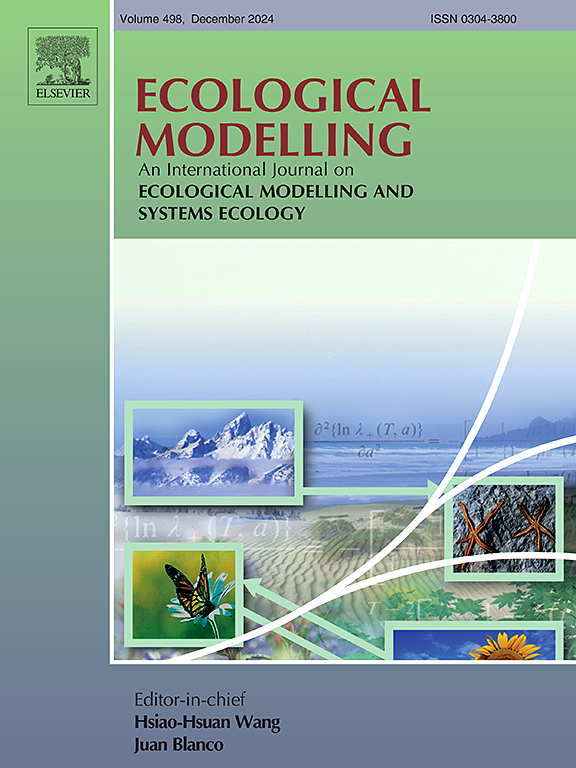探索受干扰元群落的时空动态:干旱河网中物种抵抗和恢复策略的机制建模方法
IF 3.2
3区 环境科学与生态学
Q2 ECOLOGY
引用次数: 0
摘要
了解自然干扰机制如何驱动生物多样性是一项重大的研究挑战。然而,物种的生态策略和干扰机制如何在时空上塑造元群落的结构仍然知之甚少。在干燥河网(DRNs)中,干燥事件破坏了可及范围内的当地栖息地和流动区段之间的连通性。干-再湿循环改变了两个主要机制:生态漂移和扩散动力学。在这项研究中,我们提出了一个机制元群落模型,模拟了物种抵抗干燥的能力(抗性策略)和在重新湿润后重新定居的能力(以物种的扩散速度和扩散距离为特征的恢复策略)。将该模型与现实水文模型相结合,我们模拟了四个欧洲drn中包含可变流量间歇状态的群落动态。我们研究了流动间歇性、网络连通性和物种生态策略在形成时空元群落模式中的相对重要性。研究表明,更高的连通性增加了河段α-多样性,降低了河段时间β-多样性,而流动间歇性则具有相反的效果。在元群落尺度上,更多的间歇性DRNs表现出较低的平均α-多样性和较高的空间β-多样性,而下游干燥的DRNs表现出较高的时间β-多样性。在元群落尺度上,高水平的物种抗旱性和分散性抵消了流动间断性的影响,导致α-多样性均值较高,而β-多样性时空分布较低。相比之下,扩散距离对时空β-多样性具有复杂的非线性影响,因为扩散放大了群落的随机性和生物同质化。我们的工作强调受干扰群落的随机再定殖和生物同质化如何与物种恢复力和抗性策略相互作用,以塑造生物多样性的时空结构本文章由计算机程序翻译,如有差异,请以英文原文为准。
Exploring the spatio-temporal dynamics of disturbed metacommunities: A mechanistic modeling approach to species resistance and resilience strategies in drying river networks
Understanding how natural disturbance regimes drive biodiversity is a major research challenge. Yet, how species’ ecological strategies and disturbance regimes shape the structure of metacommunities across space and time remains poorly understood. In drying river networks (DRNs), drying events disrupt both local habitat within reach and connectivity among flowing sections. Drying-rewetting cycles alter two major mechanisms: ecological drift and dispersal dynamics. In this study, we present a mechanistic metacommunity model that simulates species’ ability to withstand drying (resistance strategy) and to recolonize communities after rewetting (resilience strategy characterised by species’ dispersal rate and dispersal distance). Coupling this model with realistic hydrological models, we simulated community dynamics in four European DRNs encompassing variable flow intermittence regimes. We investigate the relative importance of flow intermittence, network connectivity and species’ ecological strategies in shaping spatio-temporal meta-community patterns.
We show that higher connectivity increases reach-level α-diversity and decreases reach-level temporal β-diversity, whereas flow intermittence has the opposite effects. At the metacommunity scale, more intermittent DRNs exhibited low mean α-diversity and high spatial β-diversity, while DRNs with downstream drying exhibited high temporal β-diversity. Finally, we show that high levels of species drying resistance and dispersal counteract the effect of flow intermittence, leading to high mean α-diversity and low spatial and temporal β-diversities at the metacommunity scale. In contrast, dispersal distance had complex, non-linear effects on spatial and temporal β-diversities, because dispersal amplifies both community stochasticity and biotic homogenisation.
Our work emphasises how stochastic recolonisation of disturbed communities and biotic homogenisation interact with species resilience and resistance strategies to shape the spatio-temporal structure of biodiversity
求助全文
通过发布文献求助,成功后即可免费获取论文全文。
去求助
来源期刊

Ecological Modelling
环境科学-生态学
CiteScore
5.60
自引率
6.50%
发文量
259
审稿时长
69 days
期刊介绍:
The journal is concerned with the use of mathematical models and systems analysis for the description of ecological processes and for the sustainable management of resources. Human activity and well-being are dependent on and integrated with the functioning of ecosystems and the services they provide. We aim to understand these basic ecosystem functions using mathematical and conceptual modelling, systems analysis, thermodynamics, computer simulations, and ecological theory. This leads to a preference for process-based models embedded in theory with explicit causative agents as opposed to strictly statistical or correlative descriptions. These modelling methods can be applied to a wide spectrum of issues ranging from basic ecology to human ecology to socio-ecological systems. The journal welcomes research articles, short communications, review articles, letters to the editor, book reviews, and other communications. The journal also supports the activities of the [International Society of Ecological Modelling (ISEM)](http://www.isemna.org/).
 求助内容:
求助内容: 应助结果提醒方式:
应助结果提醒方式:


